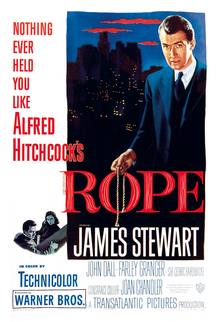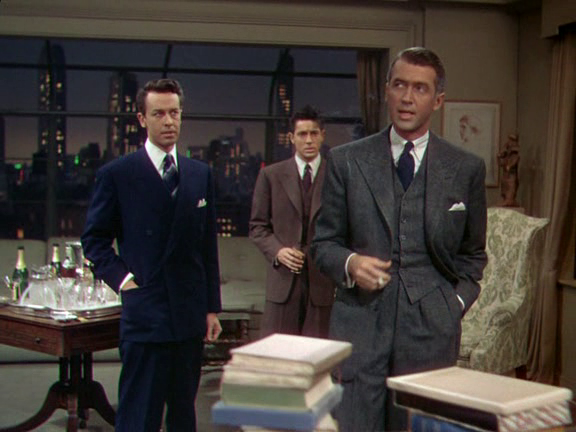Alfred Hitchcock's 1948 film Rope, is a slick and contemporary piece, years ahead of its time in terms of style, plot and delivery. The film centres around the idea of keeping a willing audience in a consistent state of suspense, not unlike the 2004 film Lemony Snicket's A Series Of Unfortunate Events, in the way they both cast an aura of frustration onto the audience as the viewer is forced to watch the work of a psychopath go unnoticed by a surrounding cast of innocent characters. Rope, almost instantly, allows the audience to witness the work of Brandon (John Dall) and Phillip (Farley Granger), a couple carrying out a murder on a fellow New Yorker and with intent to hide the body in a chest, whilst planning to host a dinner party, with the victims parents and fiancée as guests. Both Brandon and Phillip perform throughout the evening whilst dodging questions concerning the missing/deceased whereabouts of David (Dick Hogan). As the evening goes on the character of Phillip slowly deteriorates, crumbling at the seams as he begins to watch the hinges slowly fall off the doors of him and his partners perfect murder. The couple seem to have got away by the skin of their teeth, when in fact the cunning character of Rupert (James Stewart) has picked up subtle hints and tones that ultimately lead him to returning to the apartment and discovering what he fears the most, the truth.
 |
| Fig 1: Poster, Rope |
Rope is shot in a completely unique and captivating way, playing out the film in what appears to be one continuos shot, if it wasn't for the not so subtle trick of waiting for a character to pass or by or get extremely close to the camera lens to change the film, an audience would never know that the scenes are only slightly split. However that is not an insult or critique of Hitchcocks work but rather an observation of the shackles restraining work created at a time when there was a smaller limit to the length of film. This continuos shot style almost drags a viewer into the living room of this performance, forcing the audience to become a piece in this live action 'Cluedo'. Pamela Hutchinson states that this is "an experiment in real-time" (Hutchinson, 2012), something that is hard to disagree with after feeling like you've been out through one of the most twisted tales of cinema. This method of filming allows Hitchcock to almost glide through the home of the murder, causing an audience to become an external crime scene investigator, making the eye focus on a piece of evidence or hint, ultimately forcing you to wait that little extra moment for a character to discover a clue. Due to the extremely modern plot and superbly stylised camera work, Rope really lends itself to a film that could quite easily by moulded and remade into a classic of our time, not just of its own.
 |
| Fig 2: Screenshot, Rope |
Throughout Rope you can see the influences the film has shoved upon modern day cinema, with moments reminiscent of scenes from the 2010 film Shutter Island, both absolutely flush with the idea of forcing a viewer to be present amongst a scene through the use of simply displaying to an audience the clues present amongst the cast. Its has been thought that Hitchcock "made his camera a random observer in an elegant suite of rooms" (Crowther, 1948). Rope fully relys on the idea of an audience being captivated by an event and being held from that moment onwards, an idea that is occurring more and more in modern cinema, as screens are becoming populated with this idea of a viewer becoming part of a scene and almost feeling guilty of their presence in the drama. This idea of a scene feeling extremely personal is completely down to the use of camera work, the long takes and the tracking of the set as an event is being discussed, something which takes on a more modern form in the 2014 film Whiplash, a movie which throws an audience head first into the presence of a musical ensemble, trapping a viewer into feeling like they are part of the cast, almost making them feel responsible for any mistake a musician makes. This is something that the audience feels throughout Rope, as you almost carry this weight of the murder on your own shoulders and feel responsible every time a guest at the dinner party misses a clue, as you have unwillingly become such a big part of the set and cast.
 |
| Fig 3: Screenshot, Rope |
One of the most poignant scenes in Rope is the scene involving Phillip and Rupert, when the latter is quizzing Phillip on subtle points he has picked up on throughout the dinner party, this all occurs whilst being accompanied by the monotonous ticking of a musical metronome and the sounds of a piano being played by Phillip. All these sounds being combined with the accusing and prying questions give off an extremely aggressive ambience, mimicking the presence of a bomb on set, suggesting to the audience that it is a mere matter of time before this metaphorical bomb explodes and the body of the victim is discovered, the body that has played the role of the centre piece in this psychopaths dinner party. It's a real testament to Hitchcocks work that he can create a story in which the evidence lays so openly in the presence of an innocent audience and still be able to bombard the the scene with a sense of mystery and questioning. As you really start to wonder if the guests will ever notice what is so plainly in their view.
Rope is a film that suckles the most from a viewer and a narrative, forcing an innocent viewer to become part of a crime scene and giving the, fairly minimal, plot line no choice but to shroud the audience in a sense of suspense and wonderment. Although the film has been described as "curiously limp and unfocused" (Ebert, 1984), Rope still remains a film that could stand alone in modern day cinema amongst the heavy weights of today, and revel in the fact that is one of the most unique pictures to ever force it's way into a viewers mind.
Bibliography
Crowther, Bosley, 1948, Rope (1948), http://www.nytimes.com/movie/review?res=980DE3D81630E03BBC4F51DFBE668383659EDE Accessed on: 12/1/16
Ebert, Roger, 1984, Rope, http://www.rogerebert.com/reviews/rope-1948 Accessed on: 12/1/16
Hutchinson, Pamela, 2012, My Favourite Hitchcock: Rope, http://www.theguardian.com/film/filmblog/2012/jul/27/my-favourite-hitchcock-rope Accessed on: 12/1/16
Illustration List
Fig 1, Poster, Rope, https://en.wikipedia.org/wiki/Rope_(film) Accessed on: 12/1/16
Fig 2, Screenshot, Rope, http://beermovie.net/2015/01/ Accessed on: 12/1/16
Fig 3, Screenshot, Rope, http://www.w4mp.org/library/alt-guides/dean-trench/you-may-be-in-a-political-drama-if/ Accessed on: 12/1/16
Bibliography
Crowther, Bosley, 1948, Rope (1948), http://www.nytimes.com/movie/review?res=980DE3D81630E03BBC4F51DFBE668383659EDE Accessed on: 12/1/16
Ebert, Roger, 1984, Rope, http://www.rogerebert.com/reviews/rope-1948 Accessed on: 12/1/16
Hutchinson, Pamela, 2012, My Favourite Hitchcock: Rope, http://www.theguardian.com/film/filmblog/2012/jul/27/my-favourite-hitchcock-rope Accessed on: 12/1/16
Illustration List
Fig 1, Poster, Rope, https://en.wikipedia.org/wiki/Rope_(film) Accessed on: 12/1/16
Fig 2, Screenshot, Rope, http://beermovie.net/2015/01/ Accessed on: 12/1/16
Fig 3, Screenshot, Rope, http://www.w4mp.org/library/alt-guides/dean-trench/you-may-be-in-a-political-drama-if/ Accessed on: 12/1/16

"This is something that the audience feels throughout Rope, as you almost carry this weight of the murder on your own shoulders and feel responsible every time a guest at the dinner party misses a clue, as you have unwillingly become such a big part of the set and cast." Great observation, Lewis!
ReplyDeletenitpick time! Another read-though would reveal a number of typos :( You also refer to 'Brandon' playing the piano, when it's Phillip who is the pianist - and you don't need to italicise the character's names.
Well-written and interesting review, Lewis! I really enjoyed reading it :)
ReplyDeleteOkay Phil I've had a look through and hopefully sorted it! And thank you Jackie!
ReplyDelete